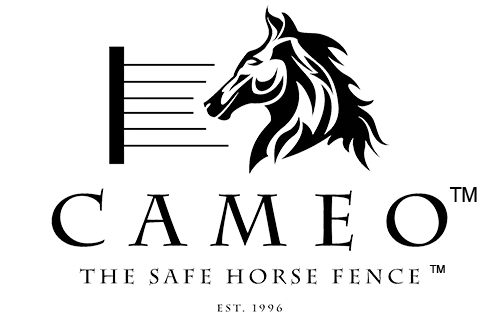Head on over to our Youtube Channel for more videos on all our Cameo™ Horse Fence System parts.
What Are the Most Common Horse Fencing Materials?
Choosing the right horse fence starts with knowing your materials. Let's break down the most popular options:
| Material | Safety Score | Durability | Maintenance | Cost |
|---|---|---|---|---|
| Wood | ⚠️ Medium | 🔹 Moderate | 🔴 High | $$$ |
| Steel | ❌ Low | 🔹 Strong | 🔹 Low | $$$$ |
| Wire | ❌ Low | 🔹 Moderate | 🔹 Moderate | $ |
| PVC | 🔹 Moderate | 🔹 High | 🔹 Low | $$ |
| Polymer (Cameo™) | ✅ Best | 🔹 High | ✅ Low | $$ |
Which Fence Material Is Safest for Horses?
When comparing horse fencing materials, safety has to be priority number one. Here's how common materials stack up in terms of injury risk:
High-Risk:
-
Barbed Wire: Punctures and lacerations
-
Steel Pipe: No flex, blunt trauma risk
Medium-Risk:
-
Wood: Can splinter or break with impact
-
Wire Mesh: Better visibility but possible entanglement
Low-Risk:
-
Polymer (Cameo™): Flexible, visible, smooth
Why Polymer Horse Fencing is the Future
Cameo™ fencing is built from UV-stabilized, high-tensile monofilament designed specifically for horse safety. It combines strength, flexibility, and cost-effectiveness in a way traditional materials can't match:
-
Metal-free = zero laceration risk
-
UV and freeze-resistant
-
Bounces back from impact
-
Easy to tension
-
Lightweight for fast installs
Myth #4: “If It Looks Cheap, It Is Cheap”
Affordable fencing can absolutely be safe, durable, and long-lasting. Cameo™ Fence proves that cost-effective solutions don’t mean compromising on quality.
Comparing Cameo™ to Other Fence Types
Wood vs. Polymer
-
Wood warps and splinters
-
Polymer stays smooth and flexible
Steel vs. Polymer
-
Steel never gives
-
Polymer absorbs impact
PVC vs. Polymer
-
PVC gets brittle
-
Polymer flexes in cold or heat
Wire vs. Polymer
-
Wire is hard to see and dangerous
-
Polymer is high-visibility and horse-safe
Accessories that Enhance Fencing Materials
Complementing your fence with the right parts makes a big difference. Consider:
-
Gripple Fence Joiners: For quick splicing
-
Line Post Insulators: Prevent shorts and add durability
-
Corner Post Insulators: Maintain clean tension and structure
-
One Way Anchor Vises: Essential for DIYers
-
Tensioning Tools: Keep lines strong and secure
Each is designed to work seamlessly with Cameo™ systems.
The Real Cost: Installation + Long-Term Upkeep
| Fence Type | Install Time | Yearly Maintenance | Replacement Cycle |
| Wood | Long | Paint, boards | 5–7 years |
| Steel | Medium | Rust check, welding | 10+ years |
| Wire | Fast | Retensioning | 3–5 years |
| PVC | Medium | Tension checks | 10 years |
| Polymer | Fast | Retighten, wipe | 20+ years |
What Do Horse Owners Say?
"Since switching to Cameo™, I haven’t had a single fence-related injury. And it's holding up perfectly after two winters."
— Kelsey R., Iowa
"I used to think wood was the only 'real' option. But Cameo™ changed my mind. Safer, cheaper, easier." — Doug M., Tennessee
Frequently Asked Questions
Q: Can polymer fencing be electrified? Yes! Cameo™ lines can be paired with solar or plug-in chargers.
Q: Is polymer fencing better for wet or snowy climates? Absolutely. Polymer fencing doesn’t rot, rust, or snap in cold temps.
Q: Can I install it myself? Yes. Cameo™ is DIY-friendly and we offer free layout consultations.
Internal Links:
External Link:
Final Word: The Smart Choice for Horse Fence Materials
When comparing horse fencing materials, polymer stands out as the smart, safe, and future-proof solution. Whether you care about your horse’s safety, your wallet, or your weekend schedule, Cameo™ offers the best of all worlds.
Durable. Affordable. Safer than anything else on the market.
Want help designing your fence? Call us at 1-800-822-5426 or email info@cameofencing.com with your pasture layout. We’ll calculate what you need—free of charge.
Ready to fence smarter? Choose Cameo™.

